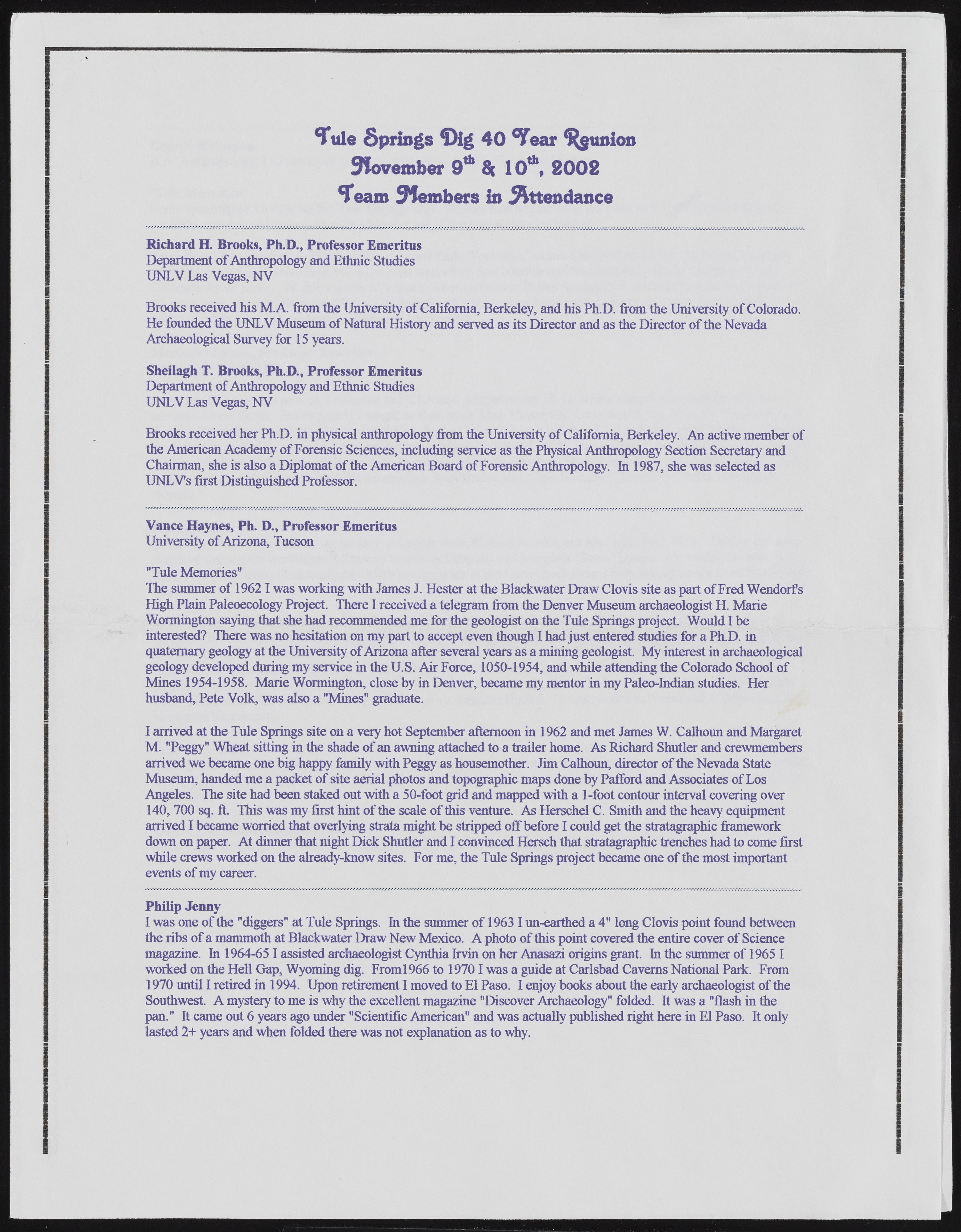Copyright & Fair-use Agreement
UNLV Special Collections provides copies of materials to facilitate private study, scholarship, or research. Material not in the public domain may be used according to fair use of copyrighted materials as defined by copyright law. Please cite us.
Please note that UNLV may not own the copyright to these materials and cannot provide permission to publish or distribute materials when UNLV is not the copyright holder. The user is solely responsible for determining the copyright status of materials and obtaining permission to use material from the copyright holder and for determining whether any permissions relating to any other rights are necessary for the intended use, and for obtaining all required permissions beyond that allowed by fair use.
Read more about our reproduction and use policy.
I agree.Information
Digital ID
Permalink
Details
More Info
Rights
Digital Provenance
Publisher
Transcription
‘Title Springs *Dig 40 Tear ^§union November 9th $ 10th, 2002 Team Members in Attendance Richard H. Brooks, Ph.D., Professor Emeritus Department of Anthropology and Ethnic Studies UNLV Las Vegas, NV Brooks received his M.A. from the University of California, Berkeley, and his Ph.D. from the University of Colorado. He founded the UNLV Museum of Natural History and served as its Director and as the Director of the Nevada Archaeological Survey for 15 years. Sheilagh T. Brooks, Ph.D., Professor Emeritus Department of Anthropology and Ethnic Studies UNLV Las Vegas, NV Brooks received her Ph.D. in physical anthropology from the University of California, Berkeley. An active member of the American Academy of Forensic Sciences, including service as the Physical Anthropology Section Secretary and Chairman, she is also a Diplomat of the American Board of Forensic Anthropology. In 1987, she was selected as UNLVs first Distinguished Professor. Vance Haynes, Ph. D., Professor Emeritus University of Arizona, Tucson "Tule Memories” The summer of 19621 was working with James J. Hester at the Blackwater Draw Clovis site as part of Fred Wendorf s High Plain Paleoeeology Project. There I received a telegram from the Denver Museum archaeologist H. Marie Wormington saying that she had recommended me for the geologist on the Tule Springs project. Would I be interested? There was no hesitation on my part to accept even though I had just entered studies for a Ph.D. in quaternary geology at the University of Arizona after several years as a mining geologist. My interest in archaeological geology developed during my service in the U.S. Air Force, 1050-1954, and while attending the Colorado School of Mines 1954-1958. Marie Wormington, close by in Denver, became my mentor in my Paleo-ftidian studies. Her husband, Pete Volk, was also a "Mines” graduate. I arrived at the Tule Springs site on a very hot September afternoon in 1962 and met James W. Calhoun and Margaret M. "Peggy" Wheat sitting in the shade of an awning attached to a trailer home. As Richard Shutler and crewmembers arrived we became one big happy family with Peggy as housemother. Jim Calhoun, director of the Nevada State Museum, handed me a packet of site aerial photos and topographic maps done by Pafford and Associates of Los Angeles. The site had been staked out with a 50-foot grid and mapped with a 1-foot contour interval covering over 140,700 sq. ft. This was my first hint of the scale of this venture. As Herschel C. Smith and the heavy equipment arrived I became worried that overlying strata might be stripped off before I could get the stratagraphic framework down on paper. At dinner that night Dick Shutler and I convinced Hersch that stratagraphic trenches had to come first white crews worked on the already-know sites. For me, the Tule Springs project became one of the most important events of my career. Philip Jenny I was one of the "diggers" at Tule Springs. In the summer of 19631 un-earthed a 4" long Clovis point found between the ribs of a mammoth at Blackwater Draw New Mexico. A photo of this point covered the entire cover of Science magazine. In 1964-651 assisted archaeologist Cynthia Irvin on her Anasazi origins grant. In the summer of 19651 worked on the Hell Gap, Wyoming dig. From1966 to 19701 was a guide at Carlsbad Caverns National Park. From 1970 until I retired in 1994. Upon retirement I moved to El Paso. I enjoy books about the early archaeologist of the Southwest. A mystery to me is why the excellent magazine "Discover Archaeology" folded. It was a "flash in the pan." It came out 6 years ago under "Scientific American" and was actually published right here in El Paso. It only lasted 2+ years and when folded there was not explanation as to why.

